Defined as “Shule City” of the Han Dynasty, Gateways and Burial Remains Discovered at Shichengzi Site, Xinjiang
An archaeological excavation implemented in 2018 at Shichengzi Site in Qitai County, Xinjiang Uygur Autonomous Region, ranged from gateways, inner area of the archaeological remains, tombs in the western part of the town to pottery kilns, and covered an area of 600 square meters, where a gateway, 2 gate piers, 4 housing foundations, 35 post holes, 7 column grooves, 20 supporting columns, 3 stepping steps and a ditch were cleared.
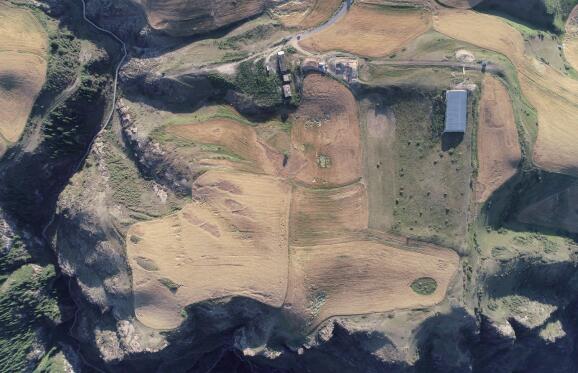
Aerial photo of Shichengzi Site

Gateway remain
The supporting columns are placed symmetrically along both sides of the gateway, which collapsed at the top, with burnt rotten wood left inside the columns. There are lots of collapsed tiles and adobes along the gateway, which was built after two processes based on the status of the remains. The gateway is 13 meters long and 4 meters wide. The rammed technique was used to make the gate piers with the same structure as the walls. There are 4 rooms, some of which there are post holes inside. F1 is 5.3 meters long and 5 meters wide; F2 is 4.3 meters long and 3.7 meters wide; F3 is 3.5 meters long and 2.7 meters wide; while F4 is 10 meters long and 5.2 meters wide. Assemblages unearthed are basically a large amount of building materials, such as pan tiles, semi-cylindrical tiles and eaves tiles, potteries, iron wares, stone tools and a piece of a WuZhu coin. The potteries uncovered are included bowls, Bo-bowls, Zhan-tea cups and jars, which are all wheel-made, and sandy mixed grey potteries without decoration. The iron wares are all rusty, not able to distinguish the shapes. The stone tools are all grindstones.
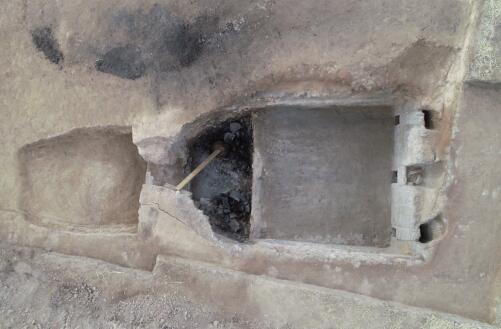
The kiln remain
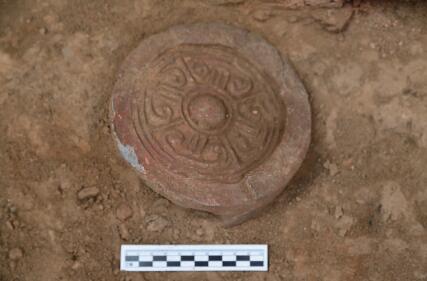
Eave tile
There were 10 tombs, a pit for sacrificial horses, a pottery kiln and a housing foundation of the Qing Dynasty. There were 6 earthen shaft pit tombs, 3 shaft pit tombs with side chamber, and a shaft with second-tiered platform, totally 3 types. The tomb owners were all supine extended buried with the heads to the west in wooden groove-shaped coffins mostly. While the inner and outer wooden coffins in the shaft pit with second-tiered platform are all of mortise and tenon joint structures. Burial goods are mostly wheel-made potteries without decoration, some of which there are poke patterns or extra strips on the surfaces, and copper artifacts, all of large scale, with 2 pieces of WuZhu coins in addition. The copper wares are basically heavily rusty ornaments, such as rings, earrings, cooper bracelets and belt buckles. Some of the tomb owners’ heads were buried along with goat bones. From the chamber of the pottery kiln, there were cleared square bricks and potteries, and pan tiles, semi-cylindrical tiles and eaves tiles are of the same technique and pattern with those of the same kind unearthed inside the city.
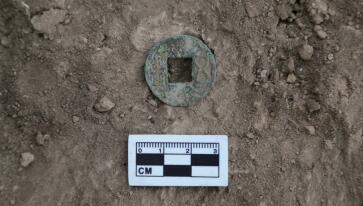
Wuzhu coin
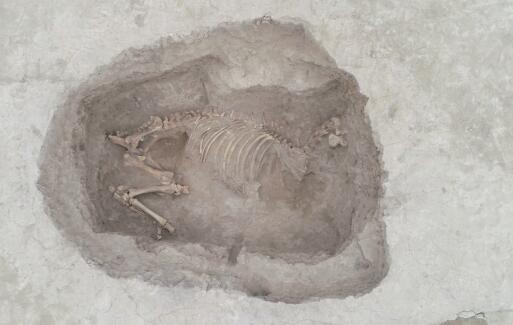
Sacrificial horse pit
As a military fortress with unique natural advantages, the Shichengzi Site built along the cliff was impregnable. Geographically, the army of Han dynasty could go through paths available for traffic and reach Shichengzi Site after climbing over the Tianshan for mutual support. According the archaeological excavations over the recent years and relevant records, the Shichengzi Site could be preliminarily affirmed as the “Shule” City. (Translator: Yuan Yuan)

